Annual willow fence care requires biannual inspections to check for brittleness, discoloration, and post stability. You’ll need to apply a 1:1 linseed oil and turpentine mixture once or twice yearly for weather protection. Prune during dry days in spring and late summer, and weave new growth into the structure for reinforcement. Keep the base elevated with gravel for drainage and monitor for pests regularly. Proper maintenance extends your fence’s lifespan from 10 to 25 years with minimal effort.
Seasonal Inspection of Willow Fence Stability
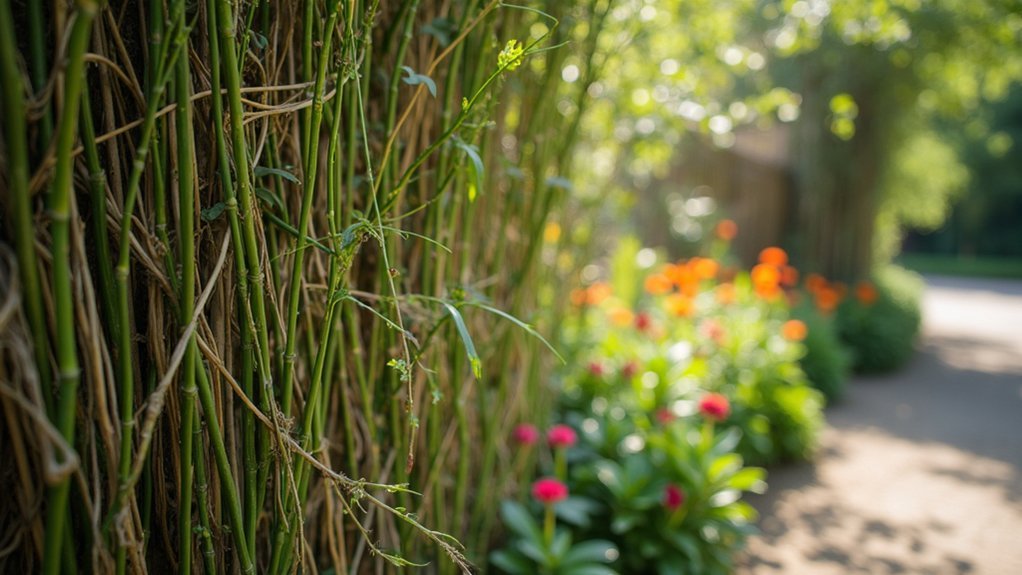
While many gardeners focus solely on seasonal plantings, your willow fence requires equally dedicated attention to maintain its rustic charm and structural integrity.
Schedule thorough inspections at least twice yearly, examining each willow fence panel for brittleness and silver-gray discoloration that signals inadequate treatment.
Regular care prevents willow fences from deteriorating—look for brittleness and silvering as warning signs of treatment failure.
Don’t overlook the essential structural elements—fence posts must remain secure without flexing or movement.
Pay special attention to the twists around end posts, as these maintain the fence’s overall integrity and prevent potential collapse.
In windy locations, you’ll need to assess whether additional middle stakes are necessary to enhance stability.
This proactive approach prevents damage during storms and extends your fence’s lifespan.
Regular inspections allow you to identify small issues before they become costly problems requiring complete replacement.
Applying Protective Treatments for Weather Resistance
Because willow fencing naturally lacks weather resistance, you’ll need to apply protective treatments regularly to extend its lifespan. The recommended mixture of boiled linseed oil and turpentine should be applied up to twice yearly for ideal protection.
| Application Method | Mixture Ratio | Coverage Notes | Drying Time |
|---|---|---|---|
| Brush | 1:1 | Both sides thoroughly | 1-2 weeks sticky |
| Spray Bottle | More turpentine | Liberal application | 1-2 weeks sticky |
| Best Season | Spring/Fall | After dry weather | Allow full drying |
| Frequency | 1-2 times yearly | When gray/silver appears | Before brittleness |
Watch for silver or gray coloring on your willow fencing as it signals the need for reapplication. Remember that freshly treated fences will remain sticky for up to two weeks, so plan your maintenance timing accordingly.
Replacing Damaged Willow Rods and Panels
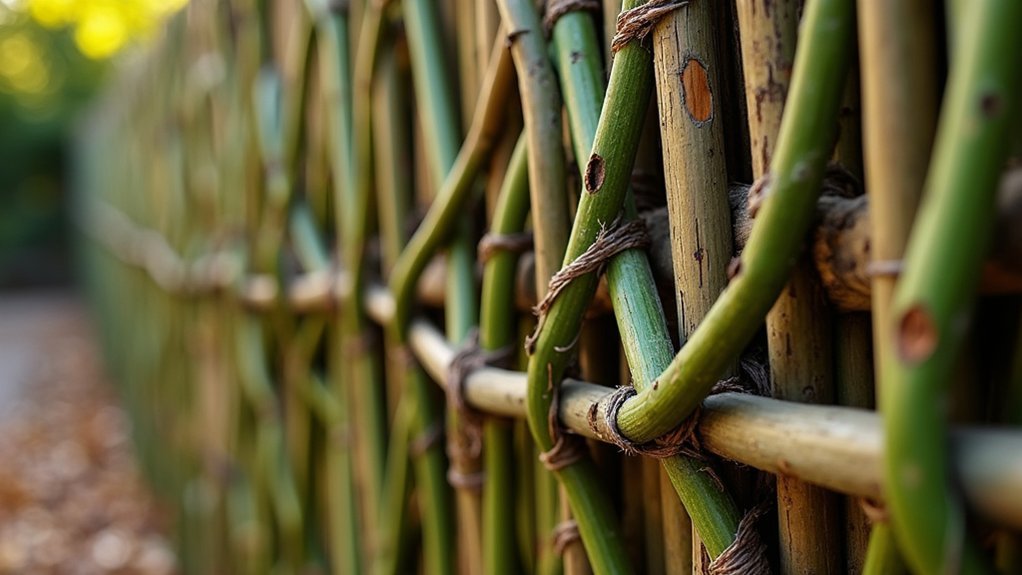
To maintain your willow fence’s integrity, you’ll need to regularly inspect for brittleness, exposed bark, or structural weakness in both individual rods and complete panels.
When you spot damage, select replacement stems from the same willow variety, cut them at a sharp angle, and insert them at least 1ft into the ground during spring or early summer for best results.
Weave new rods through the existing structure and secure them with smaller prunings to guarantee they properly integrate with your fence while maintaining its original form.
Assessing Rod Damage
Vigilance is essential when maintaining your living willow fence. Regular inspection allows you to identify damaged rods before they compromise your fence’s structural integrity.
Look specifically for willow stems that have turned silver or grey, as this coloration indicates inadequate treatment and deterioration.
When evaluating rod damage, pay attention to brittleness—healthy willow should remain flexible. Run your hand along the rods to feel for cracks or areas that seem overly dry.
Don’t overlook sections where rods connect, as these junction points often experience stress.
Early detection prevents more extensive damage. If you spot compromised rods, mark them for replacement during your next maintenance session.
Remember that even small sections of damage can quickly spread, affecting your fence’s appearance and stability if left untreated.
Panel Replacement Techniques
Once you’ve identified damaged sections in your willow fence, knowing how to replace compromised components becomes the next priority.
For individual damaged rods, select larger pruned stems and cut their ends at sharp angles for easier insertion into the woven willow structure. Weave replacement stems through the existing lattice and secure them with small prunings.
When entire panels need replacement, carefully remove the damaged section first. Install new panels by anchoring them about 1ft deep in the ground to guarantee stability.
For best results, tackle these panel replacement techniques during the growing season when fresh willow cuttings are most pliable and easier to manipulate.
Regularly check your fence for brittleness or exposed bark—these are clear signs that replacements should be made promptly to maintain your fence’s structural integrity.
Proper Pruning Techniques for Willow Fences
Pruning your willow fence during sunny, dry days twice annually will maintain its lattice pattern while preventing disease spread.
You’ll need to distinguish between shaping cuts for aesthetics and structural cuts that remove dead or diseased material, always cutting at angles away from main stems.
Sharp, clean pruning shears or secateurs work best for precise cuts, allowing you to maintain the fence’s original design while encouraging healthy new growth.
Pruning Timing Essentials
To maximize the health and appearance of your willow fence, timing your pruning sessions correctly is essential. Schedule your pruning on sunny, dry days to reduce disease risk and guarantee cuts heal properly. This weather also makes it easier to spot problem areas requiring attention.
Plan for twice-yearly pruning sessions to maintain your fence’s height and preserve its decorative lattice patterns. The best times are typically early spring before new growth emerges and mid-to-late summer after the main growing period has slowed.
When you’re pruning, separate healthy cuttings from diseased material. The healthy trimmings can be reused for new plantings or added to your compost, while diseased sections should be disposed of properly to prevent spreading problems to other plants.
Shaping Versus Structural Cuts
Understanding the difference between shaping and structural cuts is essential for maintaining your willow fence’s beauty and longevity.
Shaping cuts selectively prune branches to preserve your fence’s aesthetic and growth pattern, while structural cuts remove dead material and excess stems to promote overall health.
When pruning your willow fence, remember to:
- Make angled cuts away from main stems to prevent disease and rot
- Use sharp secateurs and loppers for clean cuts that heal faster
- Prune twice yearly on sunny, dry days to maintain the lattice structure
Tools and Techniques
Three essential tools stand at the heart of proper willow fence maintenance: sharp secateurs, sturdy loppers, and a reliable pair of gardening gloves.
When pruning your willow fence, ascertain these tools are clean to prevent disease transmission between plants.
Choose a sunny, dry day for pruning to minimize disease risk and promote healthy regrowth. Make your cuts at an angle away from main stems, which reduces rot potential and encourages better healing.
Focus on removing dead, diseased, or dying material first, then address excess new growth that disrupts your fence’s lattice structure.
Regularly inspect your fence for silver or grey coloration and exposed bark—these indicators signal when additional maintenance is needed.
With proper tools and techniques, you’ll direct energy toward the main stems and preserve your fence’s structural integrity.
Weaving New Growth Into Existing Structures
Once your willow fence has established itself, weaving new growth into the existing structure becomes an essential maintenance task for enhancing its strength and appearance.
Perform this work during the growing season when stems remain flexible and easier to manipulate. When weaving, insert the new stems at least 1ft deep into the ground to guarantee proper stability for your woven fence.
- Carefully intertwine new stems through the existing lattice to maintain your fence’s desired shape
- Secure the woven ends using small prunings to prevent unraveling
- Check the structure regularly to confirm successful integration of new growth
This integration process strengthens your fence over time, creating a denser, more resilient barrier that continues to improve with each season’s maintenance.
Managing Height and Width Through Targeted Trimming
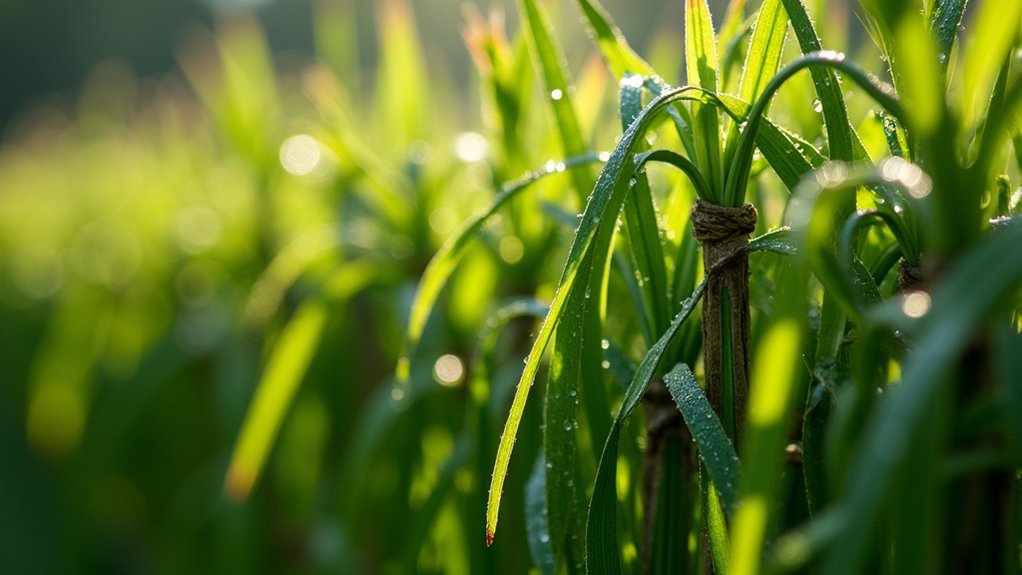
Establish clear growth boundaries for your willow fence by deciding the maximum height and width you’ll allow before beginning any pruning work.
You’ll need to perform seasonal top pruning twice yearly, using angled cuts away from main stems to prevent disease while controlling the 2-3 feet of summer growth that quickly develops.
To maintain appropriate width, implement targeted side-trimming techniques that preserve the original lattice structure while encouraging the fence to grow upward rather than outward.
Create Growth Boundaries
Maintaining the desired dimensions of your willow fence requires strategic trimming to establish clear growth boundaries. When you treat the willow structures, you’re fundamentally creating a living sculpture that needs defined limits.
Make sure you’re proactive about trimming new shoots that extend beyond your intended shape, as willow grows rapidly when woven together into fences.
- Create a height gauge from bamboo or string to maintain consistent dimensions when pruning
- Apply linseed oil to cut ends around the perimeter to discourage random growth and prevent your fence from becoming a food source for pests
- Establish a calendar reminder for a couple of weeks before spring growth begins to prepare for next year’s boundary management
Seasonal Top Pruning
Two strategic pruning sessions per year will keep your willow fence at its ideal height and width while preserving its architectural integrity.
Schedule these sessions on sunny, dry days to reduce disease risk, making angled cuts away from main stems to prevent rot.
Focus your pruning efforts on removing dead, dying, and excessive new stems.
This targeted approach redirects energy to the main structure, promoting denser, healthier growth throughout your living fence.
Always maintain your willow fence at a manageable height within arm’s reach.
This practical consideration eliminates the need for ladders during maintenance while ensuring the fence remains visually appealing.
After pruning, inspect your fence regularly to monitor new growth patterns and address any developing issues before they compromise the structure’s functionality or aesthetic appeal.
Width Control Techniques
Effective width management works hand-in-hand with top pruning to create a willow fence that’s both structurally sound and visually appealing.
You’ll need to trim excess new stems twice a year, preferably on sunny, dry days, to maintain your fence’s lattice structure and desired width.
When cutting, always angle your pruning shears away from main stems to prevent disease and rot. This technique promotes healthier regrowth while protecting the fence’s structural integrity.
- Use a height gauge during trimming sessions to guarantee consistent width across the entire fence line
- Focus on maintaining the original lattice structure while removing only what’s necessary
- Ascertain main stems receive adequate sunlight and energy by removing crowded growth that creates excessive shade
Pest and Disease Prevention Strategies
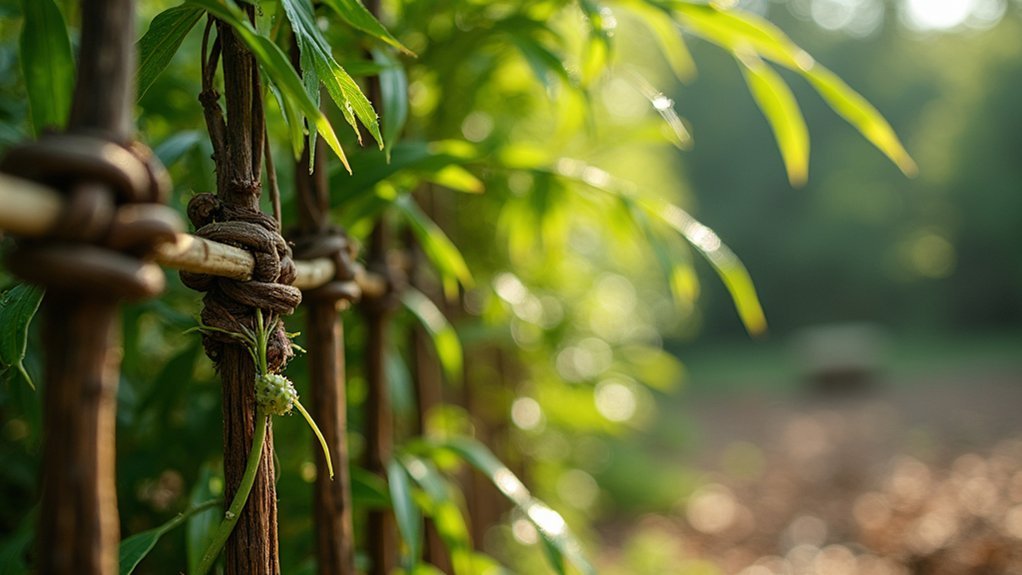
Because willow fences remain vulnerable to various pests and diseases throughout the year, regular inspection forms your first line of defense.
Check frequently for aphids and caterpillars that weaken your fence’s structure and overall health.
Maintain proper spacing and shape to guarantee adequate air circulation, which greatly reduces fungal disease risks.
When you notice early signs of pest activity, apply organic treatments like neem oil or insecticidal soap, paying special attention to leaf undersides where insects hide.
Keep the base of your fence clear of weeds and garden debris to eliminate pest habitats and reduce competition for essential nutrients.
Monitor soil moisture carefully—overwatering creates perfect conditions for root rot and other moisture-related diseases.
Establishing this preventive maintenance routine will help your willow fence remain robust and visually appealing throughout the seasons.
Base Support Maintenance and Ground Contact Issues
While pest prevention safeguards the visible portions of your willow fence, the base often requires special attention as your fence’s critical foundation.
Regularly inspect the bottom of panels for rot or damage, especially where they meet the ground. Install post savers to create a protective barrier against soil moisture, considerably extending your fence’s lifespan.
The foundation of fence longevity begins with vigilant inspection and proper moisture barriers at the critical soil-panel interface.
Never allow willow panels to directly contact soil—this promotes decay by preventing proper airflow.
If you’ve installed your fence in an area prone to dampness, consider these solutions:
- Elevate the fence base using a gravel layer to improve drainage
- Install additional supports to keep panels above ground level
- Check post stability quarterly, especially after heavy rains or freeze-thaw cycles
Cleaning Methods to Remove Debris and Mold
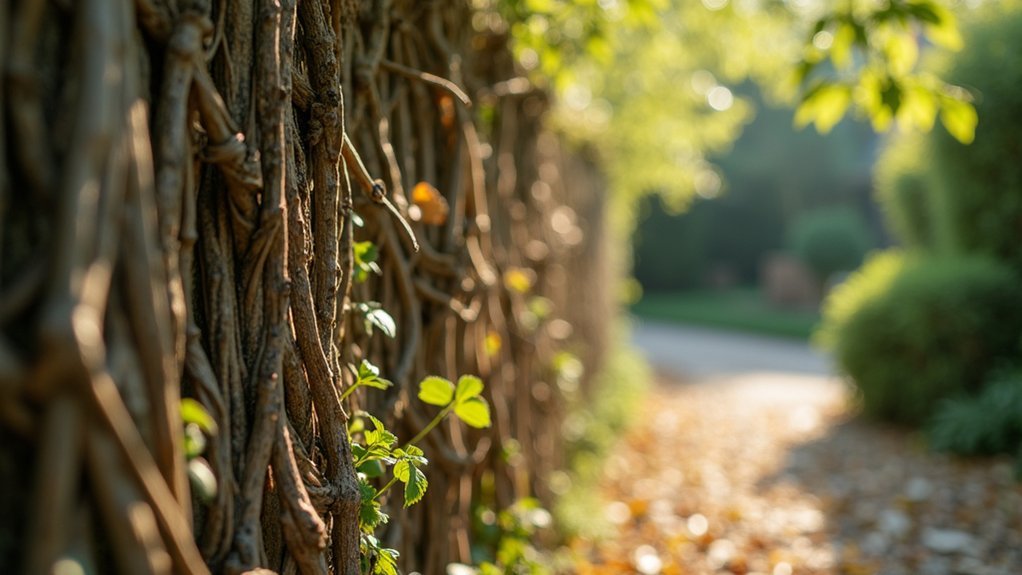
Regular cleaning becomes essential to preserving your willow fence’s integrity and appearance. Remove leaves, twigs, and other debris from the fence surface promptly to prevent moisture retention that leads to mold growth.
For general cleaning, use a soft brush or cloth to gently scrub the willow material without causing damage. When you encounter stubborn mold or mildew, apply a mixture of water and mild soap with a sponge, then rinse thoroughly with clean water to prevent chemical residue.
Always inspect your fence for discoloration or deterioration, as these signs indicate areas needing more intensive cleaning.
After cleaning, verify the fence dries completely before applying a protective treatment of boiled linseed oil and turpentine to extend its lifespan.
Winter Preparation and Frost Protection
As winter approaches, your willow fence requires specific protection against freezing temperatures and harsh conditions.
Begin by pruning dead or diseased sections to promote healthier spring growth. Apply a protective coating of boiled linseed oil and turpentine mixture to shield the willow from frost damage and prevent brittleness that often occurs in untreated fences.
Don’t forget these essential winter preparations:
- Add a thick layer of mulch around the base to insulate roots and retain moisture
- Check and secure all support structures and stakes before strong winter winds arrive
- Regularly inspect for signs of frost damage, especially after severe cold snaps
These preventative measures will greatly extend your willow fence’s lifespan and maintain its structural integrity throughout the winter months.
Repairing Loose Bindings and Connections
Three critical areas of your willow fence require consistent attention: the bindings, joints, and connection points. Inspect these regularly for any loosening that could compromise your fence’s structural integrity and lead to more extensive damage.
When you discover loose sections, promptly secure them with additional twine or natural cord. Ascertain you’re creating tight bindings that maintain the fence’s original shape and strength.
Pay special attention to areas exposed to strong winds or where soil shifts frequently, as these sections often need extra reinforcement.
Areas in high winds or shifting soil demand extra reinforcement to prevent structural failure of your willow fence.
Replace any frayed or damaged ties with fresh, durable materials rather than trying to salvage worn bindings. For peak fence maintenance, schedule these repair tasks during your annual spring or fall checkup when the willow is dormant and easier to work with.
Extending Lifespan With Linseed Oil Treatments
To considerably extend your willow fence’s natural lifespan, linseed oil treatments provide essential protection against weathering and decay.
Apply a mixture of equal parts boiled linseed oil and turpentine with a brush, ensuring both sides of your fence receive thorough coverage. For spray application, use slightly more turpentine in the mixture for better flow.
Watch for these signs your fence needs treatment:
- Silver or grey coloration developing on the willow
- Exposed bark becoming visible
- Brittle or dry texture when touched
A single Fence Panel Protector pack efficiently covers up to four 6ft x 6ft panels.
For ideal protection, apply this treatment up to twice yearly, which will greatly extend your willow fence’s durability against the elements.
Companion Planting to Reinforce Willow Fence Durability
Strategic companion planting around your willow fence doesn’t just enhance your garden’s aesthetics—it considerably strengthens your fence’s structural integrity and longevity.
Consider planting clover or legumes near your fence to naturally boost soil nitrogen levels, creating ideal conditions for willow growth.
Deep-rooted plants like comfrey work wonders in stabilizing surrounding soil, preventing erosion that might compromise your fence’s foundation.
For pest management, introduce aromatic herbs such as lavender or mint, which deter harmful insects while attracting beneficial ones.
Sunflowers and marigolds provide dual benefits—they offer protective shade from harsh weather while adding vibrant color to your boundary line.
When selecting companions, choose species that share willow’s moisture preferences to create a balanced ecosystem that reduces maintenance needs and promotes mutual growth.
Frequently Asked Questions
How Do You Maintain a Willow Fence?
To maintain a willow fence, you’ll need to apply linseed oil and turpentine yearly, prune twice annually, water regularly (especially when newly installed), and use a height gauge to manage growth and weaving.
How Long Will a Willow Fence Last?
Your willow fence will last 8-10 years with proper maintenance. You’ll get an extra 2-3 years by treating it with linseed oil, and adding climbing plants can extend its lifespan by 5 more years.
How Do You Treat a Willow Fence?
To treat your willow fence, mix equal parts of boiled linseed oil and turpentine. Apply this mixture to both sides using a brush or spray bottle. You’ll need to reapply once or twice yearly for best protection.
How to Maintain a Willow Hedge?
To maintain a willow hedge, prune it twice yearly, guarantee consistent moisture during establishment, control weeds, and apply linseed oil/turpentine treatment annually. You’ll also want to coppice during early seasons for denser growth.
In Summary
Your willow fence needs consistent care to thrive. Make seasonal inspections, apply protective treatments, and replace damaged sections promptly. Don’t forget to prune properly, weave in new growth, and prepare for winter. Fix loose connections when you spot them, and use linseed oil to extend your fence’s life. Consider companion planting for added stability. With these simple maintenance steps, you’ll enjoy your beautiful living fence for years to come.





Leave a Reply